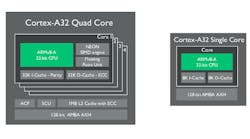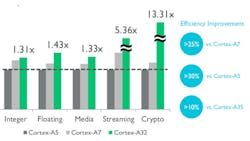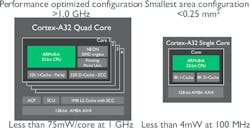32-bit ARMv8-A Core Targets IoT Space
ARM’s Cortex-A35 is a 64-bit core that is built around the ARMv8-A architecture. It is designed for entry-level smartphones (see “64-Bit Micro Targets Entry-Level Smartphones” on electronicdesign.com) and Internet of Things (IoT) applications (see “64-bit ARM Platforms Target the IoT Cloud” on electronicdesign.com). It was at the other extreme from the high-performance, 64-bit Cortex-A57 that tackles everything from high-end smartphones to SDN/NFV applications (see “Cortex-A57 SoC Targets SDN/NFV Applications” on electronicdesign.com).
It was a surprise to hear about ARM’s new 32-bit Cortex-A32 core that is built around the ARMv8-A architecture. It targets low-power applications such as mobile IoT devices. The Cortex-A32 provides an upgrade path from the current Cortex-A5 and Cortex-A7 processors.
Of course, a 32-bit core can be smaller than a 64-bit core and footprint is often indicative of power requirements as well. Plus, quite a few IoT applications can be easily addressed with a 32-bit part.
One reason for moving to the Cortex-A32 is to take advantage of the newer architecture that includes more than 100 new instructions (Fig. 1). These new instructions address a number of areas, including enhanced floating point support, better encryption support, and improved multimedia rendering.
The Cortex-A32 allows developers to take advantage of the new instructions and architecture to provide more performance while being more power-efficient (Fig. 2). The platform also supports ARM’s TrustZone security, including secure boot and trusted execution.
The Cortex-A32 will be available in configurations up to four cores (Fig. 3). A single core can use as little as 4 mW/100 MHz. A four-core system uses more, but 75 mW/core is very good for a 1 GHz operating frequency. Of course, a four core system can run a single core at a low frequency to gain power efficiency.
ARM’s 64-bit architecture offers developers an upgrade path, but the Cortex-A32 allows developers to gain most of the new features available in the 64-bit platforms while retaining the 32-bit environment with its better space and power efficiency. The big advantage is the compatibility with the existing 32-bit Cortex-A processors.
The nomenclature may be a bit confusing, given the bit-size differences between it and the Cortex-A35, but the Cortex-A32 will likely be the platform of choice moving forward for the low end of the Cortex-A marketplace.




